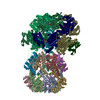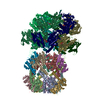[English] 日本語
 Yorodumi
Yorodumi- PDB-8xop: Cryo-EM structure of ClpP1P2 in complex with ADEP1 from Streptomy... -
+ Open data
Open data
- Basic information
Basic information
| Entry | Database: PDB / ID: 8xop | ||||||
|---|---|---|---|---|---|---|---|
| Title | Cryo-EM structure of ClpP1P2 in complex with ADEP1 from Streptomyces hawaiiensis | ||||||
 Components Components |
| ||||||
 Keywords Keywords | HYDROLASE / protease / protein degradation / proteostasis / proteolysis | ||||||
| Function / homology |  Function and homology information Function and homology informationendopeptidase Clp / endopeptidase Clp complex / ATP-dependent peptidase activity / protein quality control for misfolded or incompletely synthesized proteins / ATPase binding / serine-type endopeptidase activity / cytoplasm Similarity search - Function | ||||||
| Biological species |  Streptomyces hawaiiensis (bacteria) Streptomyces hawaiiensis (bacteria)synthetic construct (others) | ||||||
| Method | ELECTRON MICROSCOPY / single particle reconstruction / cryo EM / Resolution: 2.8 Å | ||||||
 Authors Authors | Xu, X. / Long, F. | ||||||
| Funding support |  China, 1items China, 1items
| ||||||
 Citation Citation |  Journal: mBio / Year: 2024 Journal: mBio / Year: 2024Title: Structural insights into the Clp protein degradation machinery. Authors: Xiaolong Xu / Yanhui Wang / Wei Huang / Danyang Li / Zixin Deng / Feng Long /  Abstract: The Clp protease system is important for maintaining proteostasis in bacteria. It consists of ClpP serine proteases and an AAA+ Clp-ATPase such as ClpC1. The hexameric ATPase ClpC1 utilizes the ...The Clp protease system is important for maintaining proteostasis in bacteria. It consists of ClpP serine proteases and an AAA+ Clp-ATPase such as ClpC1. The hexameric ATPase ClpC1 utilizes the energy of ATP binding and hydrolysis to engage, unfold, and translocate substrates into the proteolytic chamber of homo- or hetero-tetradecameric ClpP for degradation. The assembly between the hetero-tetradecameric ClpP1P2 chamber and the Clp-ATPases containing tandem ATPase domains from the same species has not been studied in depth. Here, we present cryo-EM structures of the substrate-bound ClpC1:shClpP1P2 from , and shClpP1P2 in complex with ADEP1, a natural compound produced by and known to cause over-activation and dysregulation of the ClpP proteolytic core chamber. Our structures provide detailed information on the shClpP1-shClpP2, shClpP2-ClpC1, and ADEP1-shClpP1/P2 interactions, reveal conformational transition of ClpC1 during the substrate translocation, and capture a rotational ATP hydrolysis mechanism likely dominated by the D1 ATPase activity of chaperones.IMPORTANCEThe Clp-dependent proteolysis plays an important role in bacterial homeostasis and pathogenesis. The ClpP protease system is an effective drug target for antibacterial therapy. can produce a class of potent acyldepsipeptide antibiotics such as ADEP1, which could affect the ClpP protease activity. Although hosts one of the most intricate ClpP systems in nature, very little was known about its Clp protease mechanism and the impact of ADEP molecules on ClpP. The significance of our research is in dissecting the functional mechanism of the assembled Clp degradation machinery, as well as the interaction between ADEP1 and the ClpP proteolytic chamber, by solving high-resolution structures of the substrate-bound Clp system in . The findings shed light on our understanding of the Clp-dependent proteolysis in bacteria, which will enhance the development of antimicrobial drugs targeting the Clp protease system, and help fighting against bacterial multidrug resistance. | ||||||
| History |
|
- Structure visualization
Structure visualization
| Structure viewer | Molecule:  Molmil Molmil Jmol/JSmol Jmol/JSmol |
|---|
- Downloads & links
Downloads & links
- Download
Download
| PDBx/mmCIF format |  8xop.cif.gz 8xop.cif.gz | 448.2 KB | Display |  PDBx/mmCIF format PDBx/mmCIF format |
|---|---|---|---|---|
| PDB format |  pdb8xop.ent.gz pdb8xop.ent.gz | 360.6 KB | Display |  PDB format PDB format |
| PDBx/mmJSON format |  8xop.json.gz 8xop.json.gz | Tree view |  PDBx/mmJSON format PDBx/mmJSON format | |
| Others |  Other downloads Other downloads |
-Validation report
| Summary document |  8xop_validation.pdf.gz 8xop_validation.pdf.gz | 1.5 MB | Display |  wwPDB validaton report wwPDB validaton report |
|---|---|---|---|---|
| Full document |  8xop_full_validation.pdf.gz 8xop_full_validation.pdf.gz | 1.5 MB | Display | |
| Data in XML |  8xop_validation.xml.gz 8xop_validation.xml.gz | 77.7 KB | Display | |
| Data in CIF |  8xop_validation.cif.gz 8xop_validation.cif.gz | 116.8 KB | Display | |
| Arichive directory |  https://data.pdbj.org/pub/pdb/validation_reports/xo/8xop https://data.pdbj.org/pub/pdb/validation_reports/xo/8xop ftp://data.pdbj.org/pub/pdb/validation_reports/xo/8xop ftp://data.pdbj.org/pub/pdb/validation_reports/xo/8xop | HTTPS FTP |
-Related structure data
| Related structure data |  38537MC  8xn4C  8xonC  8xooC C: citing same article ( M: map data used to model this data |
|---|---|
| Similar structure data | Similarity search - Function & homology  F&H Search F&H Search |
- Links
Links
- Assembly
Assembly
| Deposited unit | 
|
|---|---|
| 1 |
|
- Components
Components
| #1: Protein | Mass: 22632.605 Da / Num. of mol.: 7 / Mutation: S113A Source method: isolated from a genetically manipulated source Source: (gene. exp.)  Streptomyces hawaiiensis (bacteria) / Gene: clpP1, clpP, CEB94_14110 / Production host: Streptomyces hawaiiensis (bacteria) / Gene: clpP1, clpP, CEB94_14110 / Production host:  #2: Protein | Mass: 24058.240 Da / Num. of mol.: 7 / Mutation: S131A Source method: isolated from a genetically manipulated source Source: (gene. exp.)  Streptomyces hawaiiensis (bacteria) / Gene: clpP2, clpP, CEB94_14105 / Production host: Streptomyces hawaiiensis (bacteria) / Gene: clpP2, clpP, CEB94_14105 / Production host:  #3: Protein/peptide | Has ligand of interest | Y | |
|---|
-Experimental details
-Experiment
| Experiment | Method: ELECTRON MICROSCOPY |
|---|---|
| EM experiment | Aggregation state: PARTICLE / 3D reconstruction method: single particle reconstruction |
- Sample preparation
Sample preparation
| Component | Name: ClpP1,ClpP2 / Type: COMPLEX / Entity ID: all / Source: MULTIPLE SOURCES |
|---|---|
| Molecular weight | Experimental value: NO |
| Source (natural) | Organism:  Streptomyces hawaiiensis (bacteria) Streptomyces hawaiiensis (bacteria) |
| Source (recombinant) | Organism:  |
| Buffer solution | pH: 7.5 |
| Specimen | Conc.: 3 mg/ml / Embedding applied: NO / Shadowing applied: NO / Staining applied: NO / Vitrification applied: YES |
| Vitrification | Cryogen name: ETHANE |
- Electron microscopy imaging
Electron microscopy imaging
| Experimental equipment |  Model: Titan Krios / Image courtesy: FEI Company |
|---|---|
| Microscopy | Model: FEI TITAN KRIOS |
| Electron gun | Electron source:  FIELD EMISSION GUN / Accelerating voltage: 300 kV / Illumination mode: FLOOD BEAM FIELD EMISSION GUN / Accelerating voltage: 300 kV / Illumination mode: FLOOD BEAM |
| Electron lens | Mode: BRIGHT FIELD / Nominal defocus max: 2000 nm / Nominal defocus min: 1000 nm |
| Image recording | Electron dose: 50 e/Å2 / Film or detector model: GATAN K3 (6k x 4k) |
- Processing
Processing
| EM software | Name: PHENIX / Version: 1.19.2_4158: / Category: model refinement | ||||||||||||||||||||||||
|---|---|---|---|---|---|---|---|---|---|---|---|---|---|---|---|---|---|---|---|---|---|---|---|---|---|
| CTF correction | Type: PHASE FLIPPING AND AMPLITUDE CORRECTION | ||||||||||||||||||||||||
| Symmetry | Point symmetry: C7 (7 fold cyclic) | ||||||||||||||||||||||||
| 3D reconstruction | Resolution: 2.8 Å / Resolution method: FSC 0.143 CUT-OFF / Num. of particles: 504306 / Symmetry type: POINT | ||||||||||||||||||||||||
| Refinement | Cross valid method: NONE Stereochemistry target values: GeoStd + Monomer Library + CDL v1.2 | ||||||||||||||||||||||||
| Displacement parameters | Biso mean: 147.2 Å2 | ||||||||||||||||||||||||
| Refine LS restraints |
|
 Movie
Movie Controller
Controller





 PDBj
PDBj

